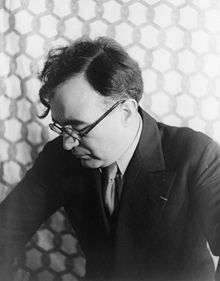Tambuco (Chávez)
| Tambuco | |
|---|---|
| by Carlos Chávez | |
 Portrait of Carlos Chávez by Carl van Vechten (1937) | |
| Composed | 1964 |
| Published | 1967 |
| Movements | 1 |
| Premiere | |
| Date | 11 October 1965 |
| Location | Leo S. Bing Theater at the Los Angeles County Museum of Art |
| Conductor | William Kraft |
| Performers | Los Angeles Percussion Ensemble |
Tambuco is a percussion-ensemble work for six players, written by the Mexican composer Carlos Chávez in 1964. The score is dedicated to Clare Boothe Luce, and a performance of it lasts approximately thirteen minutes.
History

The impulse to compose Tambuco came about in an unusual way. In 1950, Clare Boothe Luce had commissioned Chávez's Third Symphony, completed in 1954. Their unlikely friendship continued for nearly three decades and, after Luce began working in mosaics in 1963, they agreed to exchange commissions for works from each other. For Chávez, Luce created a 4' x 5' mosaic titled Golden Tiger, which he hung in his Lomas de Chapultepec studio in Mexico City. In return, he created Tambuco (Parker 1984, 63; a photograph of the mosaic is reproduced in Parker 1984, 62).
The premiere took place on 11 October 1965 in the Leo S. Bing Theater at the Los Angeles County Museum of Art, performed by the Los Angeles Percussion Ensemble conducted by William Kraft (Anon. 1965; Peterman 1986, 35). Both Chávez and Luce were in the audience (Parker 1984, 63).
Instrumentarium
Each of the six performers plays a battery of at least six different instruments. Melodic (pitched) instruments are found in each of the players' groups, which also each include wood, metal, and membrane instruments (Peterman 1986, 36–37). The total array is:
|
|
|
Analysis
Instead of the conventional procedures of thematic repetition and development, Tambuco unfolds in what the composer describes as "a constant process of consequent evolution. That is to say, an initial idea serves as an 'antecedent' to a 'consequent', which in turn immediately becomes an antecedent to a new consequent, and so on until the end of the piece" (Chávez 1967, 1). Chávez elsewhere characterizes such a procedure as being "like a spiral" (Chávez 1961, 84)
The work falls into three main sections, each characterized by the predominance of certain instruments:
- Rasps, rattles, and blocks (b. 1–158)
- Definite-pitched instruments (glockenspiel, celesta, vibraphone, chimes, and marimba, b. 159–207), ending with a xylophone transition passage (b. 208–15)
- Timpani, bongos, conga, and bass drums (b. 216–283).
This main structure is followed by a coda (beginning in b. 284) in which the definite-pitched instruments gradually re-enter, leading to an abrupt ending (Hall 2008, 59).
References
- Anon. 1965. "Monday Concerts Bow with Works Composed in the 60s". Los Angeles Times (10 October): B24.
- Bernheimer, Martin. 1965. "Inventive New Works Mark First Music Society Concert". Los Angeles Times (13 October): D13.
- Chávez, Carlos. 1961. Musical Thought. The Charles Eliot Norton Lectures, 1958–1959. Cambridge: Harvard University Press. Spanish translation, as El pensamiento musical. Sección de obras de arte. México: Fondo de Cultura Económica, 1979. ISBN 968-16-0082-7.
- Chávez, Carlos. 1967. Tambuco, for Six Percussion Players (score). Miami: CPP Belwin, Inc.
- Hall, John Richard. 2008. "Development of the Percussion Ensemble through the Contributions of the Latin American Composers Amadeo Roldán, José Ardévol, Carlos Chávez, and Alberto Ginastera". DMA diss. Columbus: The Ohio State University.
- Parker, Robert L. 1984. "Clare Booth Luce, Carlos Chávez, and Sinfonía No. 3". Latin American Music Review/Revista de Música Latinoamericana 5, no. 1 (Spring–Summer): 48–65.
- Peterman, Timothy James. 1986. "An Examination of Two Sextets of Carlos Chávez: Toccata for Percussion Instruments and Tambuco for Six Percussion Players". DMA diss. Denton: University of North Texas.
Further reading
- Stevenson, Robert. 1973. "Latin America". In Music in the Modern Age, edited by Frederick William Sternfeld, 407–32. A History of Western Music 5. London: Weidenfeld and Nicolson; New York: Praeger Publishers. ISBN 978-0297995616.